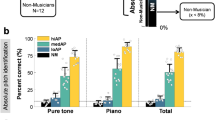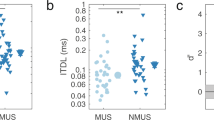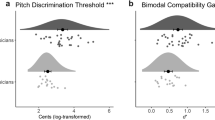Abstract
Amusia (commonly referred to as tone-deafness) is a difficulty in discriminating pitch changes in melodies that affects around 4% of the human population. Amusia cannot be explained as a simple sensory impairment. Here we show that amusia is strongly related to a deficit in spatial processing in adults. Compared to two matched control groups (musicians and non-musicians), participants in the amusic group were significantly impaired on a visually presented mental rotation task. Amusic subjects were also less prone to interference in a spatial stimulus-response incompatibility task and performed significantly faster than controls in an interference task in which they were required to make simple pitch discriminations while concurrently performing a mental rotation task. This indicates that the processing of pitch in music normally depends on the cognitive mechanisms that are used to process spatial representations in other modalities.
This is a preview of subscription content, access via your institution
Access options
Subscribe to this journal
Receive 12 print issues and online access
$209.00 per year
only $17.42 per issue
Buy this article
- Purchase on Springer Link
- Instant access to full article PDF
Prices may be subject to local taxes which are calculated during checkout







Similar content being viewed by others
References
Stewart, L., von Kriegstein, K., Warren, J.D. & Griffiths, T.D. Music and the brain: disorders of musical listening. Brain 129, 2533–2553 (2006).
Allen, G. Note-deafness. Mind 3, 157–167 (1878).
Peretz, I., Champod, A.S. & Hyde, K. Varieties of musical disorders. The Montreal Battery of Evaluation of Amusia. Ann. NY Acad. Sci. 999, 58–75 (2003).
Sloboda, J.A., Wise, K.J. & Peretz, I. Quantifying tone deafness in the general population. Ann. NY Acad. Sci. 1060, 255–261 (2005).
Peretz, I. Brain specialization for music. New evidence from congenital amusia. Ann. NY Acad. Sci. 930, 153–165 (2001).
Peretz, I. et al. Congenital amusia: a disorder of fine-grained pitch discrimination. Neuron 33, 185–191 (2002).
Hyde, K.L. & Peretz, I. Brains that are out of tune but in time. Psychol. Sci. 15, 356–360 (2004).
Cuddy, L.L., Balkwill, L.L., Peretz, I. & Holden, R.R. Musical difficulties are rare: a study of “tone deafness” among university students. Ann. NY Acad. Sci. 1060, 311–324 (2005).
Patel, A.D., Foxton, J.M. & Griffiths, T.D. Musically tone-deaf individuals have difficulty discriminating intonation contours extracted from speech. Brain Cogn. 59, 310–313 (2005).
Ayotte, J., Peretz, I. & Hyde, K. Congenital amusia: a group study of adults afflicted with a music-specific disorder. Brain 125, 238–251 (2002).
Foxton, J.M., Dean, J.L., Gee, R., Peretz, I. & Griffiths, T.D. Characterization of deficits in pitch perception underlying 'tone deafness'. Brain 127, 801–810 (2004).
Griffiths, T.D. et al. Spatial and temporal auditory processing deficits following right hemisphere infarction. A psychophysical study. Brain 120, 785–794 (1997).
Pratt, C.C. The spatial character of high and low tones. J. Exp. Psychol. 13, 278–285 (1930).
Rusconi, E., Kwan, B., Giordano, B.L., Umilta, C. & Butterworth, B. Spatial representation of pitch height: the SMARC effect. Cognition 99, 113–129 (2006).
Astur, R.S., Ortiz, M.L. & Sutherland, R.J. A characterization of performance by men and women in a virtual Morris water task: a large and reliable sex difference. Behav. Brain Res. 93, 185–190 (1998).
Collins, D.W. & Kimura, D. A large sex difference on a two-dimensional mental rotation task. Behav. Neurosci. 111, 845–849 (1997).
Gouchie, C. & Kimura, D. The relationship between testosterone levels and cognitive ability patterns. Psychoneuroendocrinology 16, 323–334 (1991).
Rauscher, F.H. et al. Music training causes long-term enhancement of preschool children's spatial-temporal reasoning. Neurol. Res. 19, 2–8 (1997).
Sluming, V., Brooks, J., Howard, M., Downes, J.J. & Roberts, N. Broca's area supports enhanced visuospatial cognition in orchestral musicians. J. Neurosci. 27, 3799–3806 (2007).
Rauscher, F.H., Shaw, G.L. & Ky, K.N. Music and spatial task performance. Nature 365, 611 (1993).
Schellenberg, E. Music and cognitive abilities. Curr. Dir. Psychol. Sci. 14, 317–320 (2005).
Kopiez, R., Galley, N. & Lee, J.I. The advantage of a decreasing right-hand superiority: the influence of laterality on a selected musical skill (sight reading achievement). Neuropsychologia 44, 1079–1087 (2006).
Geschwind, N. & Galaburda, A.M. Cerebral lateralization. Biological mechanisms, associations, and pathology: I. A hypothesis and a program for research. Arch. Neurol. 42, 428–459 (1985).
Berenbaum, S.A. Cognitive function in congenital adrenal hyperplasia. Endocrinol. Metab. Clin. North Am. 30, 173–192 (2001).
Hausmann, M., Slabbekoorn, D., Van Goozen, S.H., Cohen-Kettenis, P.T. & Gunturkun, O. Sex hormones affect spatial abilities during the menstrual cycle. Behav. Neurosci. 114, 1245–1250 (2000).
Peters, M., Manning, J.T. & Reimers, S. The effects of sex, sexual orientation, and digit ratio (2D:4D) on mental rotation performance. Arch. Sex. Behav. 36, 251–260 (2007).
Wade, J. & Arnold, A.P. Sexual differentiation of the zebra finch song system. Ann. NY Acad. Sci. 1016, 540–559 (2004).
Hassler, M., Gupta, D. & Wollmann, H. Testosterone, estradiol, ACTH and musical, spatial and verbal performance. Int. J. Neurosci. 65, 45–60 (1992).
Sluming, V.A. & Manning, J.T. Second to fourth digit ratio in elite musicians: Evidence for musical ability as an honest signal of male fitness. Evol. Hum. Behav. 21, 1–9 (2000).
Oldfield, R.C. The assessment and analysis of handedness: the Edinburgh inventory. Neuropsychologia 9, 97–113 (1971).
Shepard, R.N. & Metzler, J. Mental rotation of three-dimensional objects. Science 171, 701–703 (1971).
Acknowledgements
Thanks to L. Franz and R. O'Shea for useful comments on the manuscript and the procedure.
Author information
Authors and Affiliations
Corresponding author
Ethics declarations
Competing interests
The authors declare no competing financial interests.
Supplementary information
Supplementary Fig. 1
The relationship between scores on the MBEA subtest and errors on the mental rotation task, with the data from two left-handed amusic subjects marked with asterisks. (PDF 78 kb)
Rights and permissions
About this article
Cite this article
Douglas, K., Bilkey, D. Amusia is associated with deficits in spatial processing. Nat Neurosci 10, 915–921 (2007). https://doi.org/10.1038/nn1925
Received:
Accepted:
Published:
Issue Date:
DOI: https://doi.org/10.1038/nn1925
This article is cited by
-
Non-magnitude sources of bias on duration judgements for blank intervals: conceptual relatedness of interval markers reduces subjective interval duration
Psychological Research (2022)
-
The Influence of Pre-stimulus EEG Activity on Reaction Time During a Verbal Sternberg Task is Related to Musical Expertise
Brain Topography (2016)
-
The effect of distractor modality and processing code on human-automation interaction
Cognition, Technology & Work (2011)
-
Zijn wij onze hersenen?
Bijblijven (2010)
-
Development of a Spatial Activity Questionnaire I: Items Identification
Sex Roles (2010)



